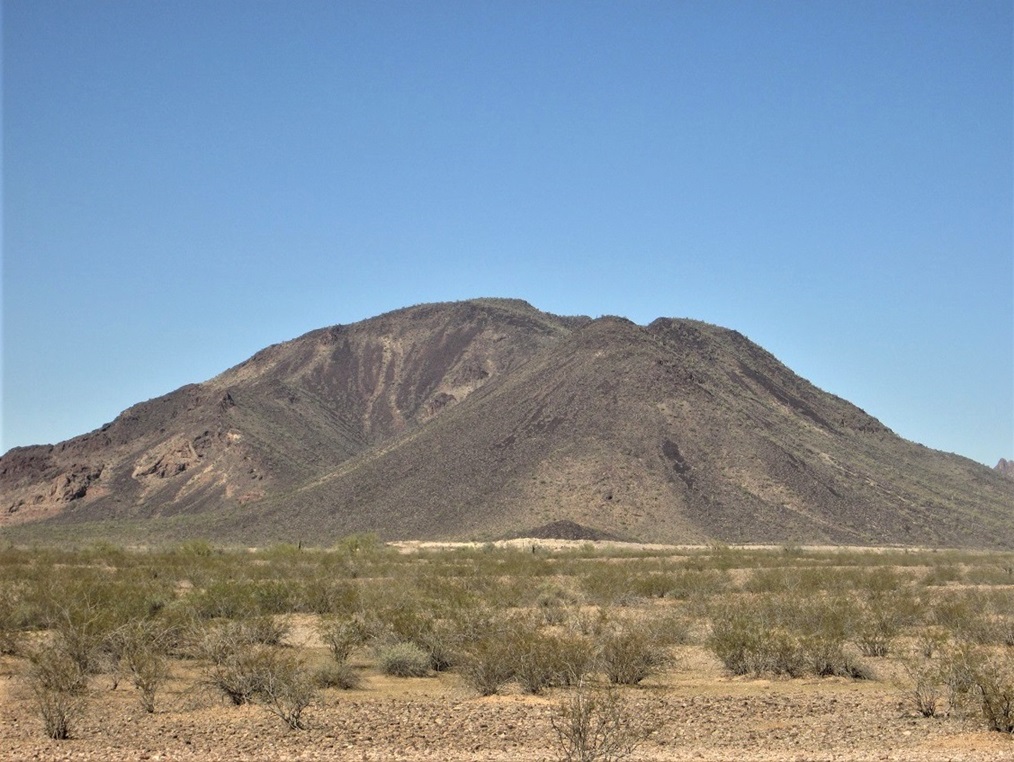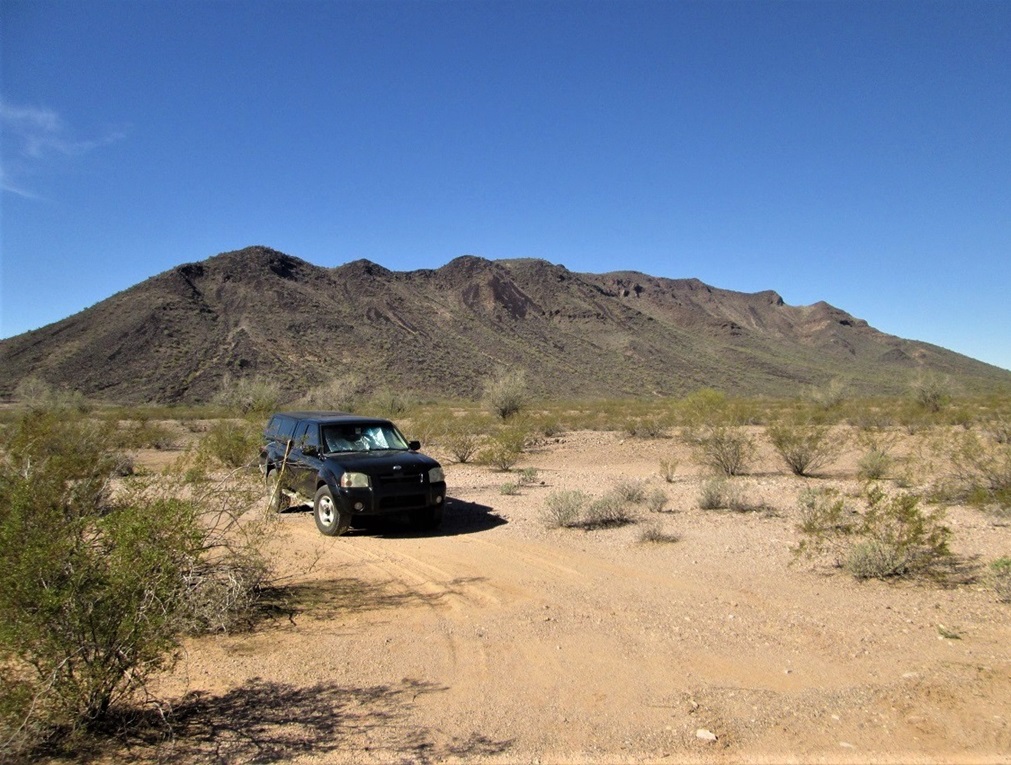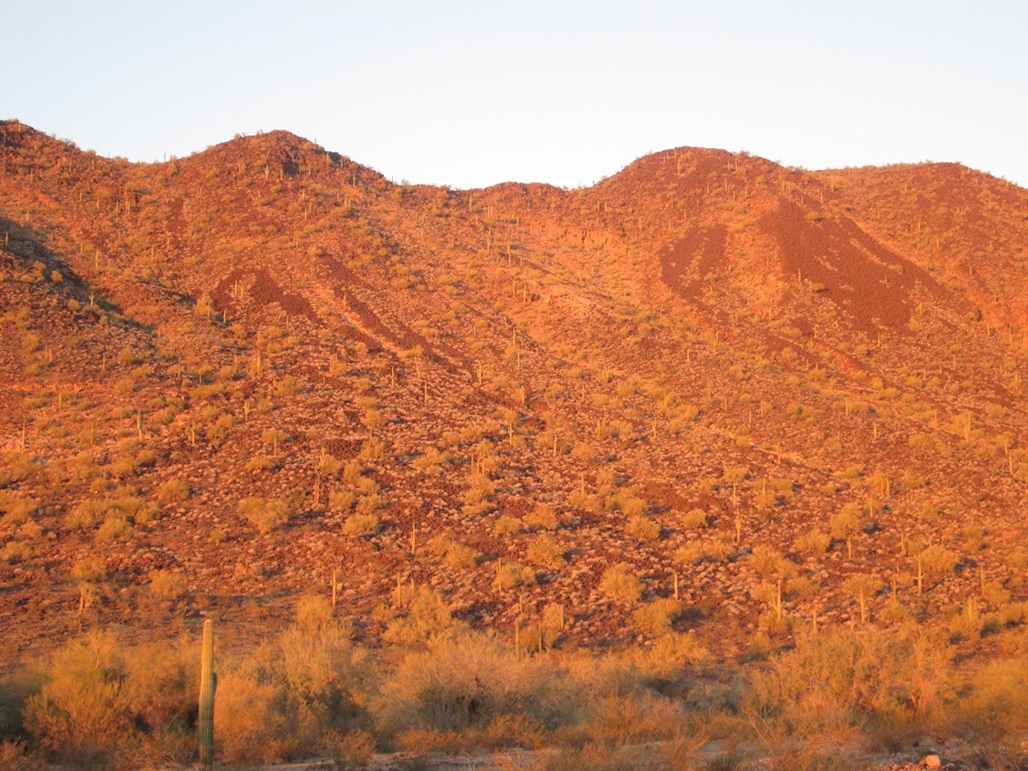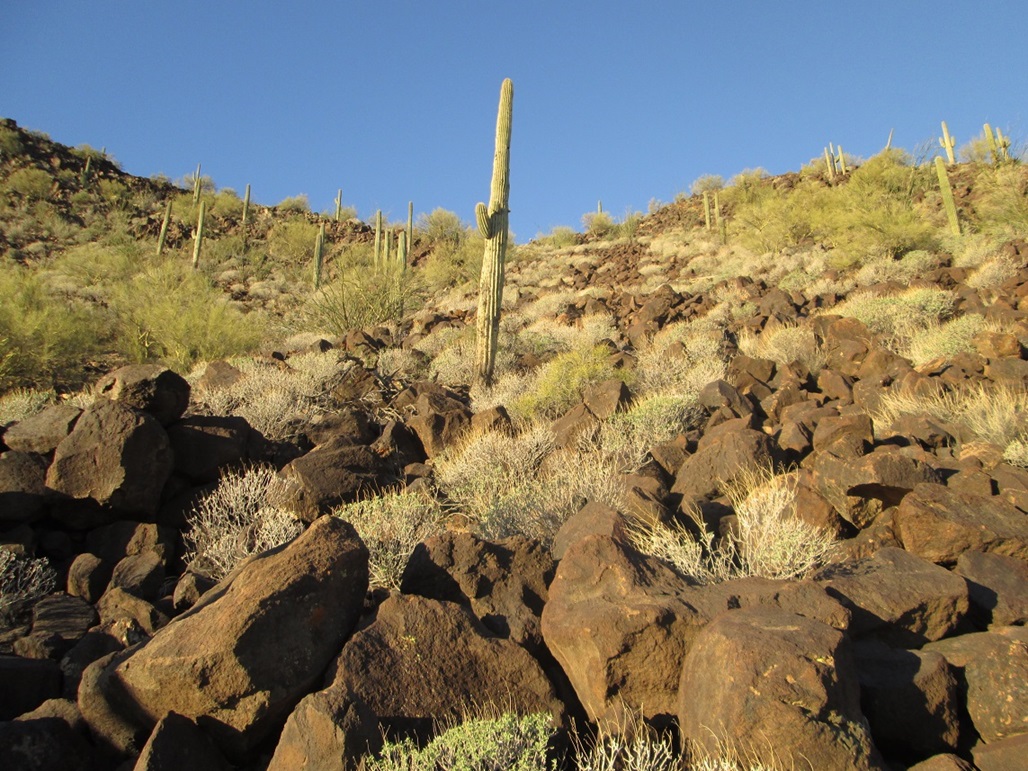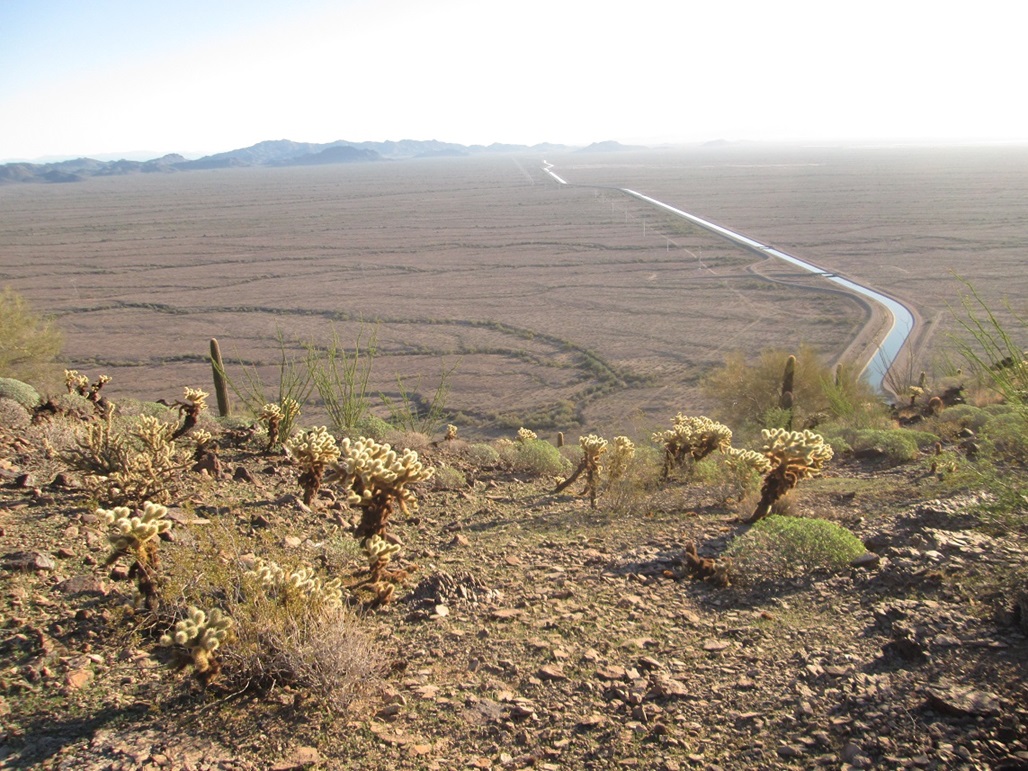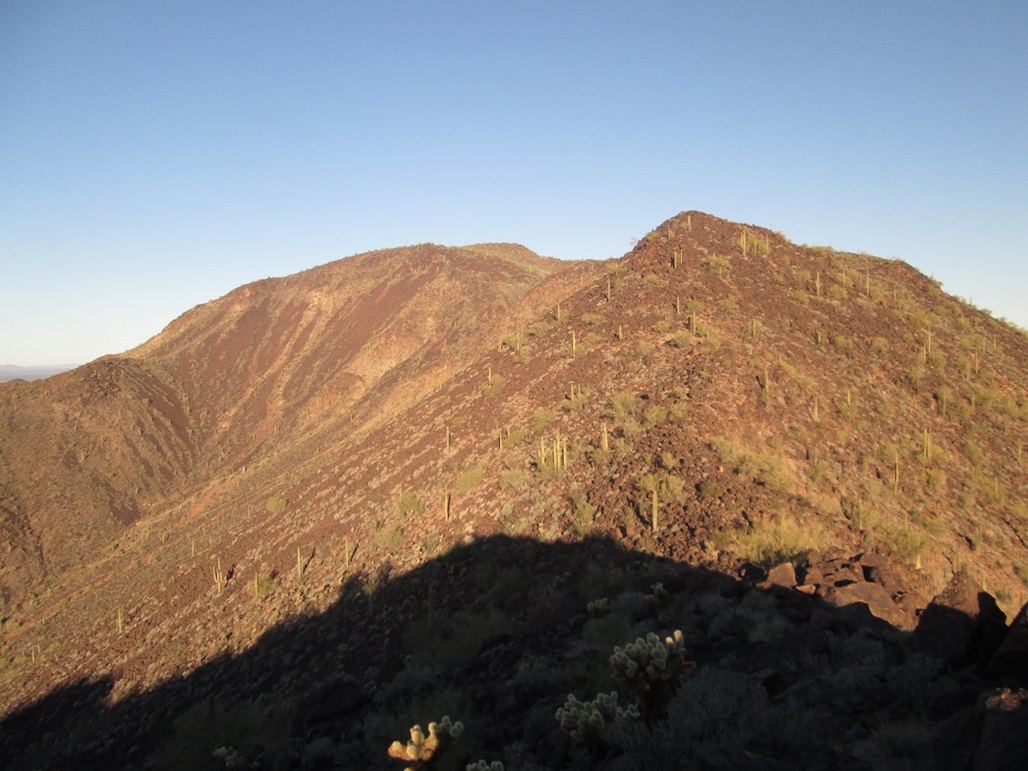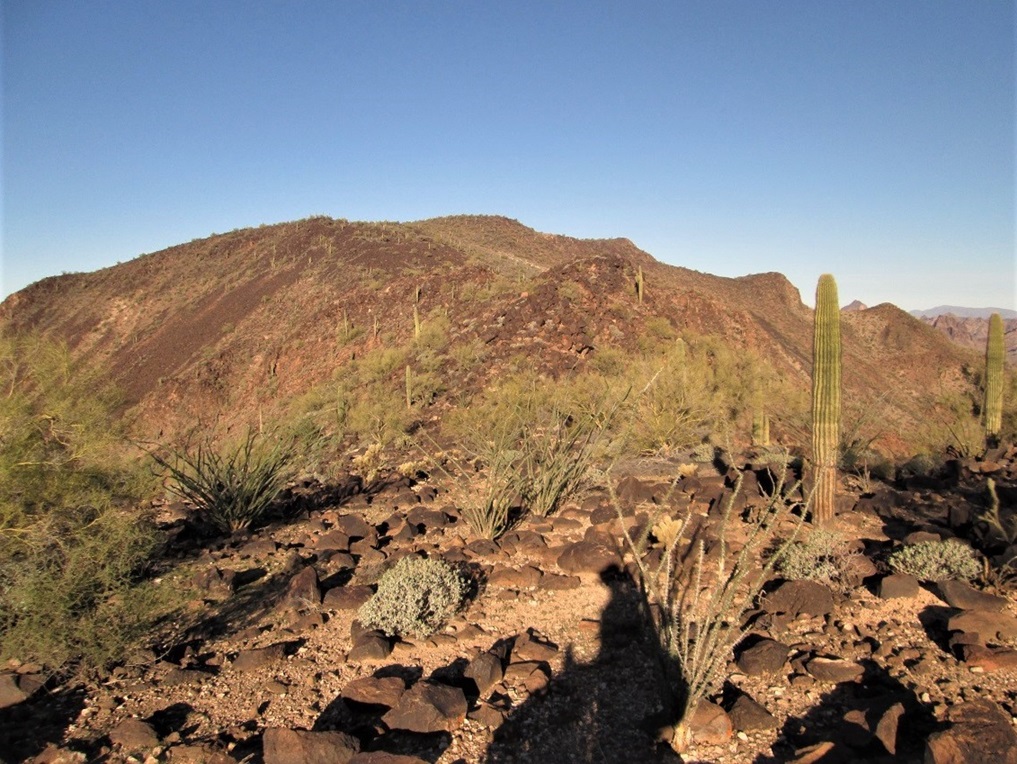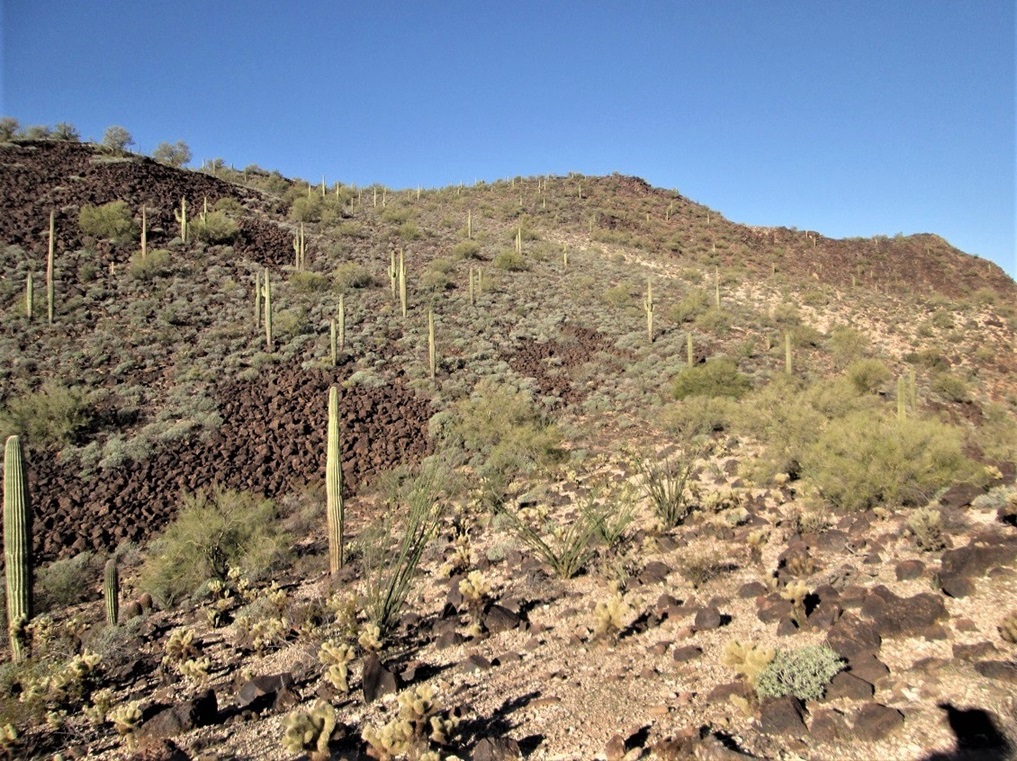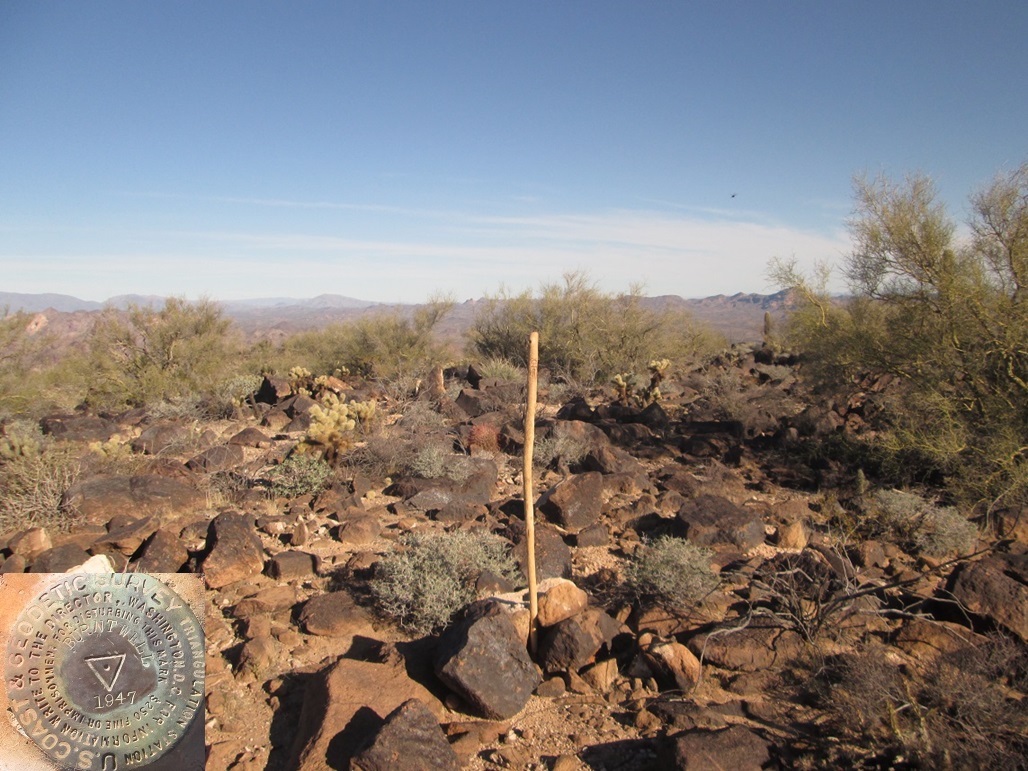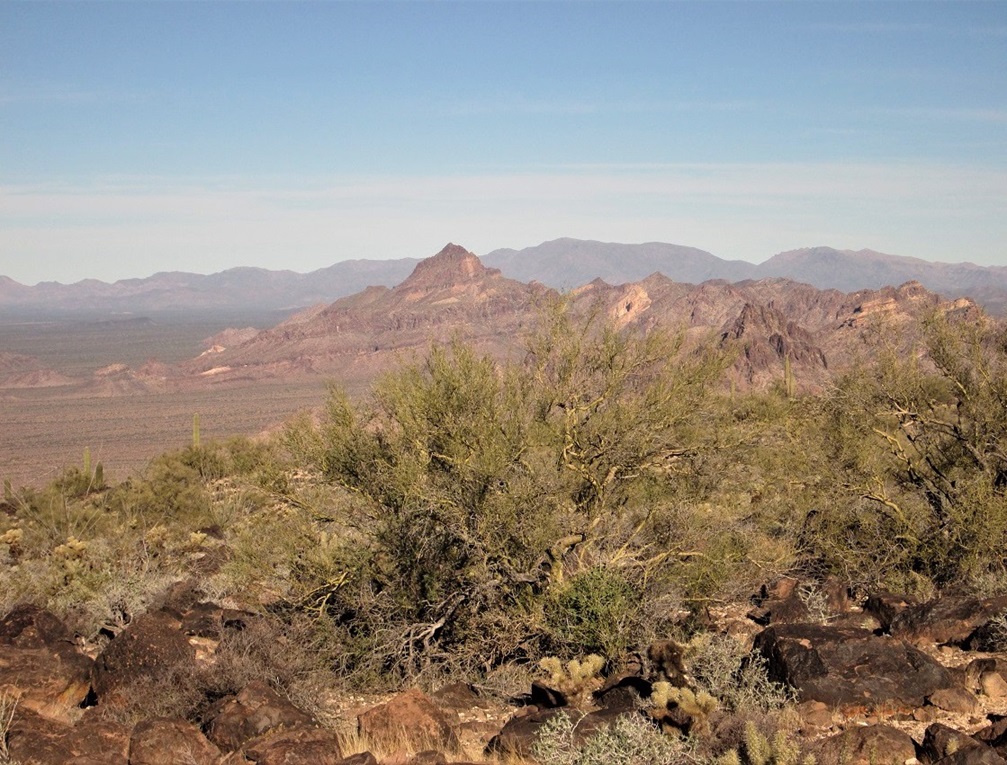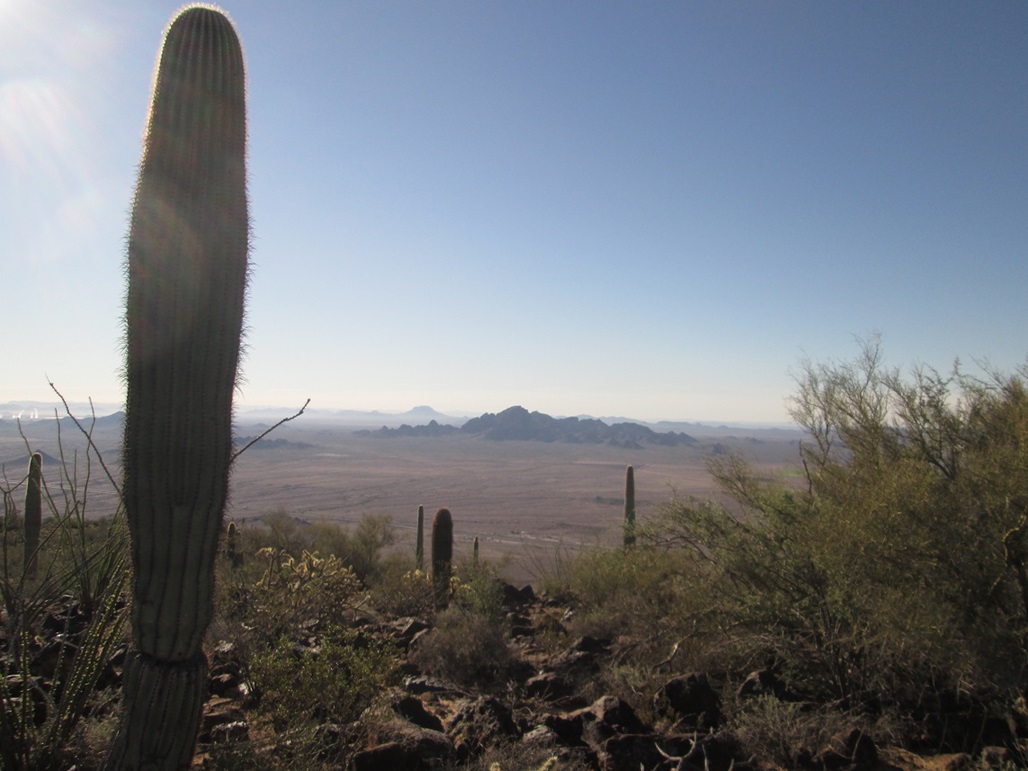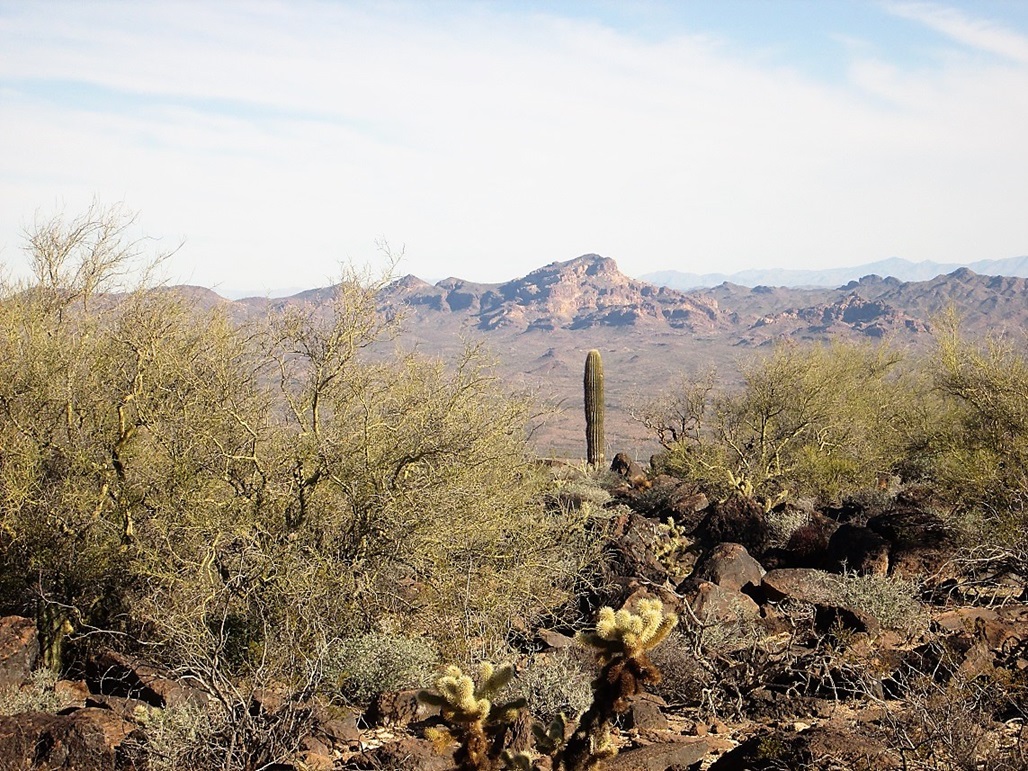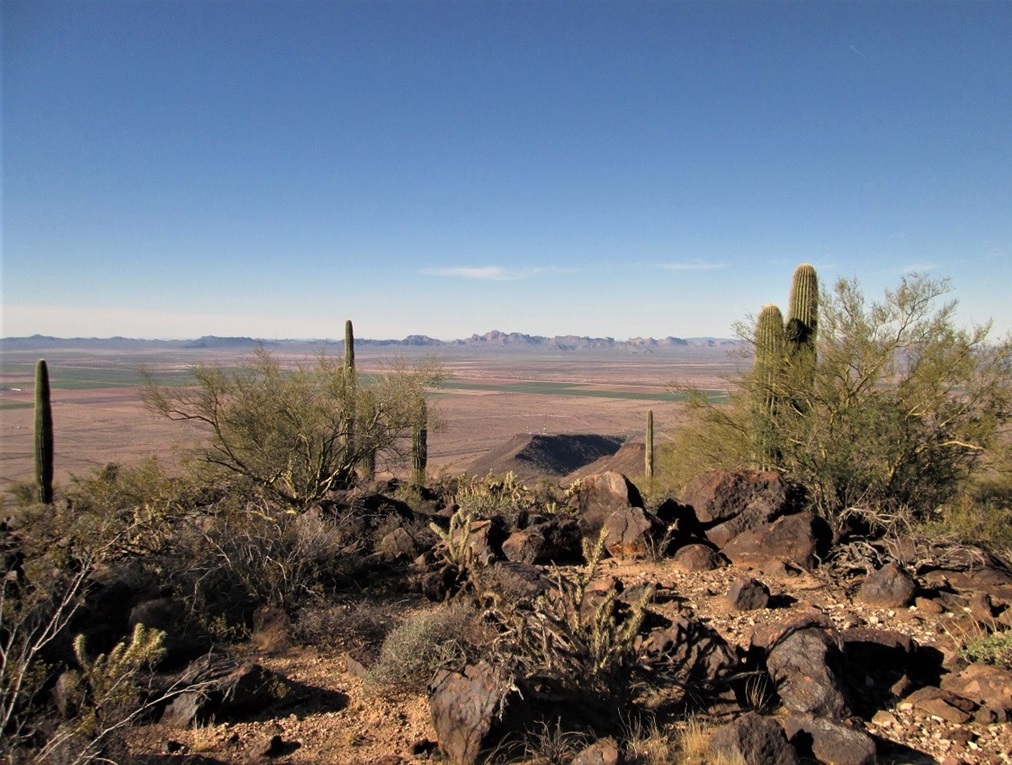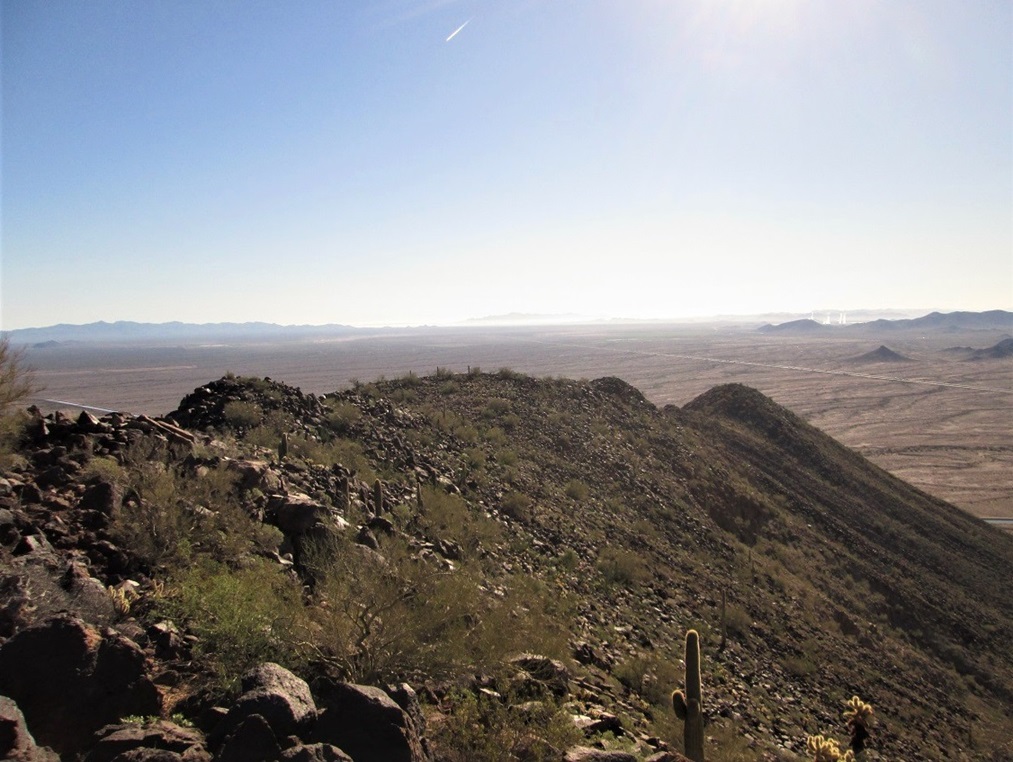
The Mountains of Arizona
• www.surgent.net
|
| Burnt Mountain |
• Big Horn Mountains • Maricopa County |
|
Date: February 14, 2016
• Elevation: 2,917 feet
• Prominence: 1,397 feet
• Distance: 4 miles
• Time: 4 hours
• Gain: 1,600 feet
• Conditions: Sunny and warm
Arizona
•
Main
•
AZ P1K
•
PB
•
USGS BM Datasheet
Burnt Mountain is a big pile of volcanic boulders about 55 miles west of downtown Phoenix. The peak sits alongside Interstate-10 and has nearly 1,400 feet of prominence, all packed tightly into one big hump with very little breadth. For years, as I have driven to and fro along the interstate, I have thought about climbing the peak. I would zoom by, and study the ridges and gullies for possible ways up, all the while not keeping my eyes on the road.
It seems so easy to access, but in reality, getting close to the base of the peak is not that obvious. The Central Arizona Project (CAP) Canal runs below the peak on its south (and north of the interstate). This effectively forms a moat, and crossing it is limited to a handful of public-access bridges spaced far apart.
I could not see where the roads that got near the peak connected with the main road-net out this way, which being this far out in the desert, is limited to just a handful of roads. There's a rest area (called the Burnt Well Rest Area) on the interstate near the peaks, but getting past the canal still posed a formidable problem.
Finally, I received useful information from Mattias Stender, who was out here a year ago, who got his info from Toddís Hiking Page, who was here over ten years ago. Why I didnít look at his site, I donít know. But now I knew how to get close to the peak. Matthias' report was encouraging. It looked like a fun peak to scale.
I left Scottsdale at 5 a.m. and drove to the 411th Avenue Exit in Tonopah, pulling into the Shell station at 6:30, the sky still dark with the sun barely starting to rise. I topped the gas and bought a few supplies. From here, I eased onto westbound Indian School Road, which is paved for a few miles, then graded dirt. The road makes a bend right, then at a sign pointing left, a scanter side road forks here. I scooted onto this littler road and followed it north toward the interstate.
This lesser road wasnít in too bad of shape. Given that it was still mostly dark, I drove slowly. In about a mile, I was at the interstate. Here, I found the little tunnel that allows access to the north side of the interstate. I then followed a better road north that paralleled power lines. In a couple miles, I drove over the bridge spanning the CAP Canal, then parked abeam of a transmission stanchion. It was a little after 7 a.m., the sun now breaking the horizon. It was cool but not cold. Daytime highs would get into the mid 80s. Not surprisingly, I was the only one here.
I got my stuff together and locked my truck, and started walking at 7:20 a.m., walking west across the desert flat, aiming for the base of the mountain, which rises suddenly out of the desert floor. There are no foothills. The demarcation is very distinct. I passed from scrubby desert sand and brush to the rocks in a matter of feet.
The rocks are blackened basalt boulders, and looking up, all the slopes were this rock, sometimes covered in saguaro or bursage, sometimes just big long bare slopes of these boulders. I started the uphill trek, the grade steepening the higher I got. There was no trick to this. It was a short and steep uphill grind of about 800 vertical to gain the ridge. The rocks were usually solid, and for long stretches, I could hop from rock to rock without ever setting foot onto the occasional patches of soil. In places, the rocks were like a long series of stair steps.
I arrived onto the ridge, slightly under an hour after starting. I took a break, then started the second leg, a one-mile walk along the ridge to the summit, still another 700 feet higher. I climbed up the first ridge bump, a gain of about 75 feet. Here, I had an excellent view of the summit off in the distance, and the series of ridge bumps along the way. It looked friendly, but a couple of the bumps looked steep. However, I was not concerned that I would encounter cliffs or other technical sections. Of more concern was the usual: cholla cactus, and snakes. It was warming up.
The ridge walk went well. Early on, I had to climb a steep slope where the talus blocks were much larger, and I had to actually use my hands in a couple places to shimmy up the rocks. There seemed to be more of these bumps than first meets the eye. This was the biggest one. Most were about 20 to 40 feet high. One other bump looked vertical from a few feet away, but closer inspection showed that the rocks on it formed almost perfect steps.
In time I was at the final saddle below the summit. The slope here was much less steep and there was more soil and less rock on the ground. I weaved through open lanes in the moderate brush, and soon arrived to the broad summit, a two-hour, ten-minute climb. After all the sharp little bumps I had to scale along the ridge, the broad and nearly-flat summit was kind of a surprise.
The views were superb. The day was blue and clear, with pleasant temperatures and a little breeze. I had front-row seats to the nearby peaks, including the rugged Big Horn Peak to the northwest, the range highpoint. Thatís a tough customer, requiring Class 3 and 4 skills to get to the top. I tried it way back in 1996 or so, and bailed very early on that attempt.
Other peaks in view were the Harquahala Mountains, Sugarloaf Peak, the Belmonts and the White Tanks when looking northwest to northeast, and the Eagletails, Saddle Mountain and the Gila Bend Mountains with Woolsey Peak when looking southwest to southeast. Down below I could see the open desert of the Big Horn Wilderness, the CAP Canal, Interstate-10 and its low hum of noise that I could hear from up here, and square green farmfields.
This peak is rarely climbed, no doubt due to the challenge of getting close to it. The actual climb was fairly simple. I was the first to sign in the log since Mattias from 2015, and the names went back to the 1990s, most years seeing one or two visits, some years, none at all. Most signatures were from people I knew. I spent about ten minutes resting before starting down.
Due to the warmth (pushing 70s by now, a record heat wave for February, highs into the low 90s), I was concerned about snakes, moreso than usual. I also was on the lookout for bighorn sheep, but I didnít see any. I did see a lot of lizards. Bees were also a concern.
I kept a consistent pace going downhill, which meant having to rescale many of those ridge-line bumps. I hopped from rock to rock. Although the vast majority were solidly in place, a few would creak or move under me. I made sure each step was sure before proceeding. Still, a couple of times, a rock would move and I would have to catch my fall or contort to regain my balance. I ended up tweaking my back ever so slightly.
Off the ridge, I descended a different slope and gully than the one I had ascended, following paths of least resistance. I encountered some scree sections and at one point I bumped into a bigger rock that rolled about five feet before stopping. Otherwise, I tried to keep to whatever looked easiest. I ended up angling down the slope rather than going straight down. I was off the slopes and back on the flats, then back to my truck, arriving at 11:20 a.m., nearly exactly 4 hours after starting.
I spent a few minutes changing and relaxing back at my truck. Then I started the drive out. Back on Indian School Road where it was still gravel, I saw a guy just lying in the road. He was disheveled and looked like a desert bum. I wondered if he was dead, but he seemed to be asleep, not in a position that one might be in had they just dropped deadÖ as if I know a lot about that. He seemed to have things under control, so I let him be.
On the drive home, I scouted some roads north of the Verrado Exit in Buckeye for a possible future hike, then followed Indian School Road all the way into the city, where I caught the Loop-101 Freeway home. I rewarded my tummy with a great Hawaiian Barbeque lunch of chicken and macaroni/rice salad.
I was happy the hike went well with no mishaps. I was happy also to finally scale this peak, after so many enticing looks while driving by it on the interstate for so many years.
|
|
